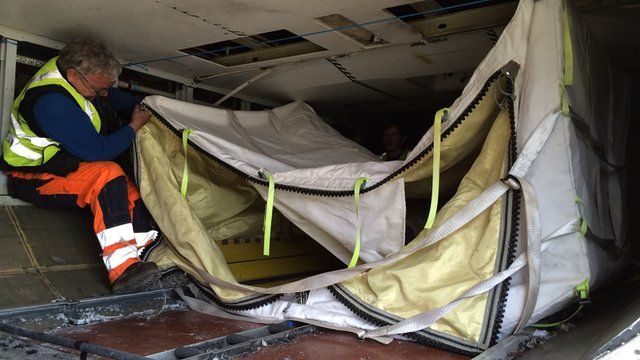

-
24 July 2015
- From the section Science & Environment

A new system to resist terrorist bombs smuggled onto aircraft has been tested in dramatic experiments.
A device called FlyBag is designed to absorb the shockwaves and shrapnel caused by explosions.
If security fails and a bomb reaches the luggage hold, the idea is that the blast would be safely contained.
The trials – using old jets at Cotswolds Airport in Gloucestershire – showed that explosions on board caused no damage.
The bag involves a novel mix of four different layers of material including one based on Kevlar, which is used in bullet-proof jackets.
The idea is that the bag is not only lightweight but also strong and flexible enough to handle the energetic effects of a blast without breaking.
Current designs for hardened luggage containers are based on reinforced metal and many airlines have seen them as too heavy and costly.
The FlyBag project is funded by the European Commission and is run by a consortium of institutes and specialist companies.
One leading figure is Dr Andy Tyas, a specialist in explosives engineering from the University of Sheffield and a director of the spin-out firm Blastech.
“We’re delighted with the way the trials have gone,” he told BBC News.
“We’ve previously tested FlyBag at our laboratory in Buxton but just in the open air.
“We knew the bag expanded and the question was: how much did that expansion cause a problem for the airframe? Does that become the devastating transmitter of energy itself? And what we’re seeing is, it’s not doing that.”
I witnessed one test for myself in which a rucksack containing a bomb was placed with other luggage inside a FlyBag in the hold of an old Airbus 320.
From a safe distance, we could hear the detonation but could not see any visible effect.
After the air and dust had cleared, I was shown how the explosion had charred some of the luggage but the bag itself had remained intact with no sign of any impact on the aircraft.
The significance is that if a bomb the same size had exploded during a flight, it would not have been catastrophic and any passengers on board would have survived.
In engineering terms, the bag is designed to cope with four separate effects of a bomb – each requiring different characteristics in response.
- The shockwave caused by the high pressure eruption can move at 20,000 mph and can only be contained with a combination of strength and flexibility.
- The fireball of incandescent gases raises temperatures to 3,000C so the bag needs to be fireproof too.
- The release of gases then fills any space with what is called “quasi-static pressure”. Dr Tyas likens this to “pumping up a bike tyre until it explodes” – so the device has to be able to expand to accommodate this without rupturing.
- And the fourth impact of a blast in a smuggled bomb is that the hard parts of the luggage – the zips and wheels of suitcases – turn into shrapnel so the bag needs to be extremely resilient.
The first airline to show interest is the Italian carrier Meridiana.
It is hoping to certify a type of FlyBag that would hang inside the luggage compartment of narrow-body jets.
A second kind will line the luggage containers that are loaded onto wide-body planes. And a third, much smaller type is designed to be ready inside the cabin in case a passenger is found with a bomb.
“We have all the ingredients to go to market – we just needed these latest tests to prove the system,” said project coordinator Donato Zangani, of the Italian consulting company D’Appolonia.
“The technology of the materials is not new but the combination of them is novel – and the trick is to be able to have a fabric only 1.3mm thick but also absorb the pressure in a predictable way,” Mr Zangani told BBC News.
“It’s about staying one step ahead.”
Follow David on Twitter: @davidshukmanbbc

